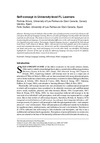Identificador persistente para citar o vincular este elemento:
https://accedacris.ulpgc.es/handle/10553/43213
| DC Field | Value | Language |
|---|---|---|
| dc.contributor.author | Arnáiz Castro, Patricia | en_US |
| dc.contributor.author | Guillén García, Félix | en_US |
| dc.date.accessioned | 2018-11-21T13:27:30Z | - |
| dc.date.available | 2018-11-21T13:27:30Z | - |
| dc.date.issued | 2012 | en_US |
| dc.identifier.issn | 1447-9508 | en_US |
| dc.identifier.uri | https://accedacris.ulpgc.es/handle/10553/43213 | - |
| dc.description.abstract | Existing research indicates that no other area of study presents as much of a threat to selfconcept as doesforeign language learning. However, few foreign language learning studies have focused explicitly on self-concept. This study is timely in view of the current interest by the Spanish government in promoting foreign languages. It examined individual differencesin the self-concept of 216 participants in a Spanish university context. Participants, English language learners, completed the Self-concept Scale Form 5-AF5 (García & Musitu, 2001). Self-concept levels both globally and in the academic, social and emotional dimensions were determined, and the relationship between self-concept, on the one hand, and gender, age, mark and language level on the other hand, was identified. The findings highlight the relevance of this type of study for informing language learning research. In addition, important implications for future research are discussed. | en_US |
| dc.language | eng | en_US |
| dc.publisher | 1447-9508 | - |
| dc.relation.ispartof | International Journal of the Humanities | en_US |
| dc.source | International Journal of the Humanities [ISSN 1447-9508],v. 9, n. 4, p. 81-92 | en_US |
| dc.subject | 58 Pedagogía | en_US |
| dc.subject | 57 Lingüística | en_US |
| dc.subject | 61 Psicología | en_US |
| dc.subject.other | Foreign Language Learning (FLL) | en_US |
| dc.subject.other | Self-concept | en_US |
| dc.subject.other | Mark | en_US |
| dc.subject.other | Language Level | en_US |
| dc.title | Self-concept in university-level FL learners | en_US |
| dc.type | info:eu-repo/semantics/Article | es |
| dc.type | Article | es |
| dc.identifier.doi | 10.18848/1447-9508/CGP/v09i04/43205 | en_US |
| dc.identifier.scopus | 84856151360 | - |
| dc.contributor.authorscopusid | 54921188600 | - |
| dc.contributor.authorscopusid | 16636403500 | - |
| dc.description.lastpage | 92 | - |
| dc.description.firstpage | 81 | - |
| dc.relation.volume | 9 | - |
| dc.investigacion | Ciencias Sociales y Jurídicas | en_US |
| dc.type2 | Artículo | en_US |
| dc.date.coverdate | Diciembre 2011 | |
| dc.identifier.ulpgc | Sí | es |
| dc.description.sjr | 0,1 | |
| dc.description.sjrq | Q4 | |
| item.grantfulltext | open | - |
| item.fulltext | Con texto completo | - |
| crisitem.author.dept | GIR IDETIC: División de Traducción e Interpretación y Aprendizaje de Lenguas | - |
| crisitem.author.dept | IU para el Desarrollo Tecnológico y la Innovación | - |
| crisitem.author.dept | Departamento de Didácticas Específicas | - |
| crisitem.author.orcid | 0000-0001-5987-8254 | - |
| crisitem.author.orcid | 0000-0002-1543-1351 | - |
| crisitem.author.parentorg | IU para el Desarrollo Tecnológico y la Innovación | - |
| crisitem.author.fullName | Arnáiz Castro, Patricia | - |
| crisitem.author.fullName | Guillén García, Félix | - |
| Appears in Collections: | Artículos | |
SCOPUSTM
Citations
3
checked on Jun 8, 2025
Page view(s)
229
checked on May 4, 2024
Download(s)
253
checked on May 4, 2024
Google ScholarTM
Check
Altmetric
Share
Export metadata
Items in accedaCRIS are protected by copyright, with all rights reserved, unless otherwise indicated.
